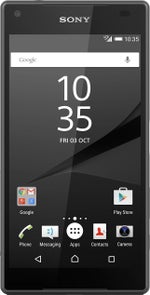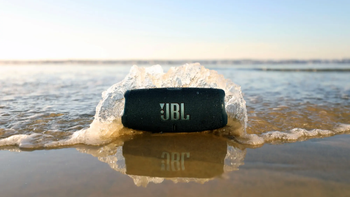Sony Xperia X Compact Review

Introduction
Sony's Compact line of Xperia phones has been earning accolades ever since its inception back in 2014 with the original Z1 Compact. It seemed that a lot of folks have been clamoring for small, manageable handsets with flagship specs, that's why Sony struck a chord and a loyal following that gladly gobbled up the original 4.3-incher, then the 4.6” Z3 and Z5 Compacts.

The small-but-powerful concept, however, has undergone a change, morphing into small-upper-midranger by using a humbler chipset, instead of a top-shelf Snapdragon 8-series one, with the respective price correction downwards. While potential X Compact customers will be happy to hear about the price drop compared to the initial tags of its predecessors, has Sony made many compromises with the new Compact line reincarnation to reach said midrange price point? Read on to find out...
In the box:
- Xperia X Compact
- Wall charger
- USB-C cable
- Warranty and info leaflets
Design
The roving munchkin design feels good in hands and pockets, but is marred by smallish, shallow keys

The X Compact has tapered, rounded edges both at the front and on the back, which, coupled with a fairly chubby 9.5mm body, makes the phone very pleasant to hold, and easy to pick up from a flat surface.
Other that that, there is nothing really remarkable or premium about the X Compact design, it's unapologetically plastic, and the shiny finish attracts fingerprints with ease. On the plus side, the plastic construction is fairly light, feels sturdy, and overall – it's not a phone you'd baby and constantly worry about like a lot of the heavy glass-and-metal creations lately. The smallish size makes it invisible in your pocket or purse, and allows you to reach everywhere on the screen with your thumb only while holding it in your palm. That was the sweet spot that attracted a lot of users to the Z Compact editions before, and Sony is changing none of it.
The front-facing stereo speakers that Sony has been known with for a while are still here, but one other signature feature is gone – the X Compact has no water-tight ratings, so don't take it in the shower like the previous Compacts. Another important change is the addition of a USB-C port, which is a first for Sony, and makes fumbling with the cable connector sides a thing of the past.

The power/lock key at the right has an embedded finger scanner, but the US versions won't have that for some reason, yet again.
The lock key is pretty small and recessed to prevent inadvertent clicks, but it is also with quite a shallow feedback, so pressing it is not a very clicky and satisfying experience. The same goes for the volume rocker and two-stage shutter key right beneath it – on top of the shallow feedback, they are very small and hard to feel and press without looking.
Display
Overly cold and oversaturated, the screen makes up for that with great outdoor visibility

Sony doesn't stray from the proven formula with the X Compact, and has equipped it with a 4.6” 720 x 1280 pixels display, just like its last two predecessors. The panel is of the IPS-LCD variety, offering very good viewing angles, and nice outdoor visibility with very low reflections and bright, 587-nit output that is enough to see everything on screen even under direct sunlight.
These are our observations about the display in everyday scenarios, but what do the cold, hard screen benchmarks reveal? Well, first off, the colors that the X Compact display offers are pretty cold to begin with, just like with its predecessors. Granted, you can crudely set the color temperature from the display settings, but there aren't many people that will tinker with those, most will grab and use the phone as it arrives. The cold colors are also way oversaturated.
Sony's X Reality engine is turned on by default, boosting colors and contrast while displaying media. We measured the screen's performance with the color management option turned off to get a more credible view of the panel's specifics. The display can be used with gloves on, which only adds to the outdoorsy cred of the phone, and there is a tap-to-wake option in the settings which comes in handy considering the recessed, shallow lock key.
Interface and functionality

Sony's interface overlay pretty much follows the stock Android Marshmallow experience – from the homescreens to the bland-looking status bar – save for a few more options in the settings screen, and a few Xperia apps thrown in for a good measure. Love it or leave it, at least the interface runs smooth and without notable hiccups. Oh, yeah, there is an app drawer, too.
Sony uses the renowned SwiftKey predictive text keyboards instead of the Google one as default, and it is easy to type on the small display by tapping or swiping with your thumb only while holding the phone with one hand – great solution for texting while driving. Not. A bunch of theming and wallpaper options are available for customizing, and each of the phone's colors comes with the respective theme hue for the interface.
Sony has added several features to make your life with the phone easier, though, that aren't present in the stock Android edition, like the tap-to-wake option for the screen, or а complete backup solution, both local and in the cloud. We also especially like the Xperia's Smart adaptive control, which senses when you hold the phone in hand, and are looking at a picture, for instance, and keeps the display on regardless of the screen sleep settings.
You will, of course, find the venerable PlayStation app that lets you tap into Sony's gaming ecosystem. It offers the PS4 Remote Play function to connect a DualShock controller, and use the phone as a portable console streaming your PS4 games, neat.
Processor and memory
The “potent munchkin” is not so potent with Snapdragon 650 instead of the 8-series, but no less capable.

The biggest difference between the previous phones in the line, and the X Compact, is the choice of chipset. Sony used to place the same top-shelf Snapdragon processor of the 8-series in the Compacts that it used in its larger flagships, but that is no more. The X Compact is run by a hexa-core Snapdragon 650 clocked at 1.8 GHz. Frankly, with Sony's light Android skinning, this felt more than enough to power through most of what you will throw at it, save possibly for the visuals of some heavy 3D games, and the synthetic benchmark scores below confirm this observation.
The system memory situation is pretty generous with 3 GB of RAM provided, and the internal storage is also very good for the category and price point, at 32 GB. Actually, the internal memory situation would be great if not for the breathtaking amount of it being occupied by the operating system itself. Out of the 32 GB of storage, Sony's software takes nearly 12 GB even before downloading any apps or altering any settings. Not cool, especially considering how close-to-stock the interface and its options are. Thankfully, there is a microSD slot for storage expansion.
Internet and connectivity
Sony uses Android's default Chrome browser for your surfing needs. The phone offers LTE-A Cat 6 up to 300 Mbps download speeds, if AT&T or T-Mobile can provide those where you live, as these are the carriers that the X Compact is compatible with in the US.
As usual, Sony also offers DLNA and Miracast support, while wired connectivity is of the trendy USB-C variant. The USB-C port offers USB 2.0 transfers only, though, and, since the MHL port is now gone, you have no option for wired streaming of the screen imagery.
Camera
“Triple image-sensing technology” can't make up for the tiny pixel size, but continuous autofocus is up there with the best.

Sony is one of the few major Android makers that still focuses on megapixel count to woo potential buyers, equipping the X Compact with a whopping 23 MP sensor. It also added laser-assisted autofocusing and RGBC-IR sensor (Red Green Blue Clear – Infra Red) white balance meter aids next to the LED flash for the first time. This “triple image-sensing technology” is supposed to make the already fast Predictive Hybrid Autofocus system now even faster, and colors more accurate. There is also a new swipe-based camera interface – one swipe left and you go into a manual mode, or swipe right and enter video mode or the camera apps like Sony's augmented reality extension.
On first brush, Sony's camera sounds impressive just by reading the terminology - 1/2.3” Exmor R image sensor coupled with 24mm wide G Lens and BIONZ image-processing engine. Whew. On second look, however, it is still a small sensor with smallish 1.1 micron pixels squeezed tightly.
Thus, while the actual photos are decent in daylight, with fine amount of detail, especially the 23 MP shots (the phone takes 8 MP photos in the default Intelligent Auto mode), they are noisy, and said detail a bit soft and mushy, especially towards the corners. The X Compact offers a far cry from the jolly, saturated “Sony colors” that its cameras used to be associated with. Instead, the photos usually come out mostly natural, with just the right dose of saturation.
Despite the RGBC-IR sensor, sometimes the white balance tilts too much to the bland, colder side, or is overly warm. The handset often overexposes brighter highlights in scenes with trickier dynamic range – like shooting against the sky as a backdrop - and is not nearly as quick to focus and shoot as the “triple image-sensing technology” phrase would suggest.
The low-light snaps are not very impressive, either – they relay the scene colors with a colder than accurate note, and there is quite a lot of digital noise visible, even without zooming in. The LED flash seem powerful enough to illuminate a close scene.
Video
The 1080p (30/60fps) video capture that the X Compact is capable of displays largely credible color representation, but lacks somewhat in sharpness and detail. Exposure adjustments while panning around are relatively slow to come, too, with some skipped frames and rolling shutter artifacts clearly visible as smearing with fast moving objects like the cars on the roundabout we shot our samples at.
The footage, however, is saved somewhat by Sony's excellent continuous autofocus system that can rival Samsung's hardwired Dual Pixel tech. Just look how it instantly focused on the white phone we raise in front of the lens in the sample below, and how quickly the sensor refocuses on the background once we take the near object out of the frame.
Sony also offers its SteadyShot 5-axis digital image stabilization which works well in keeping the footage afloat during abrupt movements of shaky hands. The phone also offers stereo audio recording while filming, though the audio capture itself is on the average side as the mics need a bit more pick-up strength.
Multimedia
Sony uses its own Album gallery, duplicating Google Photos, and its own app is prettily laid out, with an easy to navigate yet comprehensive catalog structure, and a number of editing options for your pictures or videos. The video player is capable, too, with rich codec support.
Besides pretty visuals, the music player offers a variety of equalizer presets and sound modes to take full advantage of the smorgasbord of audio features that Sony stuffs in its phones, starting from the S-Force Front Surround speakers, to the high-res lossless audio support. However, the headphone and speakers' output strength leaves something to be desired.
Call quality

One of the stereo speakers on the Xperia X Compact also doubles as the earpiece, and voices come out loud and clear enough to be called above average in call quality. The only complaint we have is that there is a slight echo chamber effect when the volume is pushed up, though the mid-level is still plenty strong for everyday purposes.
The two noise-canceling mics also did a good job weeding out ambient noise, and relaying our musings in a credible manner to the other side of the conversation, with strong sound and legible voice timbers that nevertheless sounded a tad more distorted than we would like.
Battery
Just as its predecessors, the X Compact is a “two-day” marathon runner

In the last few Z-series editions, Sony patted itself for creating “two-day battery” phones. This was especially true for the Compacts, which are still one of the longest-lasting Android phones that don't have giant batteries inside. While powerful, but quick to the heat and the throttle, Snapdragon 8-series chipsets of the last two generations chipped away at the stellar battery endurance claims somewhat, the X Compact is running on a Snapdragon 650, so can it be a true marathon runner?
Well, our battery benchmark returned almost 10 hours of screen time on a charge, which, for a 2700 mAh juicer, is worth a praise. This is similar to the result that the previous Compacts managed, and they have already proven to be “two-day battery” phones in real-life usage, so you can expect nothing less from the X Compact, too. The charging time of almost two and a half hours with the stock charger, however, is pretty slow for today's standards, though Sony will sell you a faster than the stock 1.5A charger for some extra cash.
Conclusion
At the sub-$500 price point that Sony is offering the X Compact at launch, there may be more than enough niche demand to justify its release. The only compromise made with the cutie, compared with its predecessors, is the midrange Snapdragon chipset, but that's now enough to drive the X Compact well, plus Qualcomm's last few flagship Snapdragons haven't exactly been thermal management kings, so the choice of silicon may be for the better.
Other than that, the X Compact delivers very well on most important fronts. It has a good camera with excellent focus-hunting abilities while video recording. The screen is also very bright and with low reflections, making it great for outdoor viewing. The battery life is top-notch, and call quality is loud and clear. These are all things most people are looking for in a handset, and when delivered in a small and handy package at a decent price, they make the phone stand out.
As far as the competition goes, the X Compact is really in a niche of its own right now. There's the cheaper but similarly sized Samsung Galaxy A3 (2016), which has a 4.7” display, a fancier styling, decent camera, and fine battery life, though considerably less-potent hardware. Looking away from Android, the 4.7” iPhone 6 can be found at a similar price point today, and can actually get you much more phone for the money. In the X Compact's $450-$500 range, however, there is little in Android's small-and-strong category but its predecessor, the Z5 Compact, which happens to be a more powerful handset, at a lower price right now.
Software version of the review unit:34.1.А.1.198


































Things that are NOT allowed: